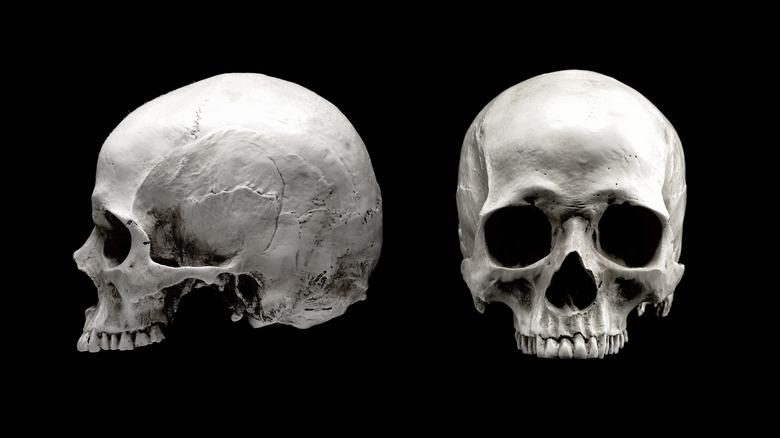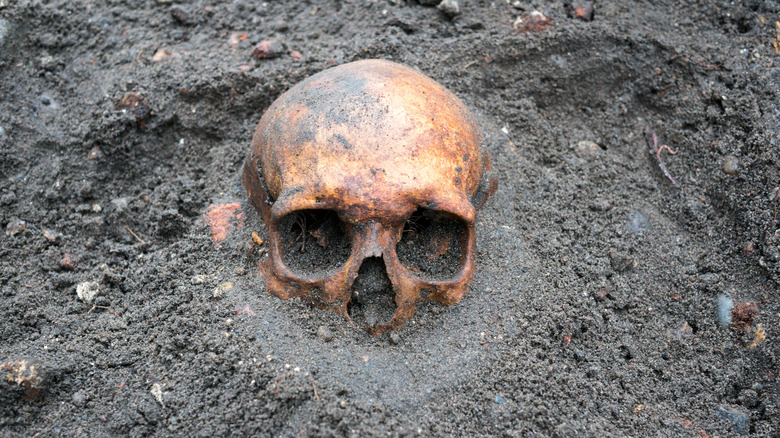What Were The Only Human Remains Recovered From The La Brea Tar Pits?
The famous La Brea Tar Pits lie in the beating heart of Los Angeles, known for housing a plethora of fossilized animals from 50,000 years ago and onward. Transforming from an ancient forest to a modern city park, the excavation site is one of the prime paleontological discoveries in history, yielding everything from ice age mammals to ancient plants over the course of more than 100 excavations between the 19th century and today. The specimens from this site are vast and number in the hundreds of thousands, including saber-toothed cats and mammoths (via La Brea Tar Pits and Museum).
The tar pits became a history book embedded in the Earth when animals became trapped in the tar (or pitch). The oil surfaced in prehistoric times and eventually solidified into mounds of asphalt that now hold the remains of prey animals and predators alike. Much like carnivores such as the short-faced bear and dire wolf became trapped while preying on immobile animals, there is evidence that humans may have exploited animals that were stuck in the thick tar. Marks from potential stone tools have been discovered on the bones of a saber-toothed cat. But in 1914, it was discovered that a young Native American woman may have also fallen prey to the glutinous, black pits (per The Travel).
When the body was discovered
In 1914, the site of the La Brea Tar Pits was known as Rancho La Brea, a Mexican land grant of over 4,400 acres. By the turn of the century, the scientific potential of the tar pits was undeniable; by 1905, geologists had confirmed the presence of fossil animals in the asphalt. During the period of 1905 to 1915, American and foreign institutions got involved in excavations, resulting in over 750,000 fossil discoveries (via La Brea Tar Pits and Museum). An excavation in 1914 brought to the surface the skull of a 10,000-year-old woman, whose death would prove both fascinating and mysterious.
Soon after her discovery, the bones were put on exhibit at what would later become the George C. Page Museum. Before the philanthropist commissioned a museum onsite at the tar pits, the Los Angeles Museum of History, Science, and Art housed the site's fossils, beginning during the peak of the excavations (per La Brea Tar Pits and Museum). The "La Brea Woman" exhibit had the bones placed next to a dummy that approximated her height and weight, with the intention of recreating her appearance. The exhibit remained on display until 2004, when it was removed from the museum (via Los Angeles Times).
The mysteries of the remains
The La Brea Woman had fractures on her skull that some speculated were her cause of death. While on exhibit, the missing bone from the fracture was patched up, but it was evident that she also had a broken jaw. This led to speculation that blunt force trauma from another individual in her tribe may have resulted in her untimely demise. This has never been proven. It is known, however, that the 18- to 22-year-old died young. It is also known that she stood no higher than 4 feet 10 inches, and a dental analysis showed that stone-ground meal made up most of her diet (via Los Angeles Times).
The remains of a dog were found within close proximity, leading some to posit that La Brea Woman was buried in the tar pits ritualistically. But research published in PaleoAmerica proved that the association between the dog and woman was incidental, since the dog died over 3,000 years ago. Her tribal origins remain mysterious as well, with the Tongva or Chumash people being possible candidates (via The Travel). Many unknowns still surround La Brea Woman over 100 years after her initial discovery, but she continues to stand as an intriguing chapter in L.A.'s ample fossil record.


